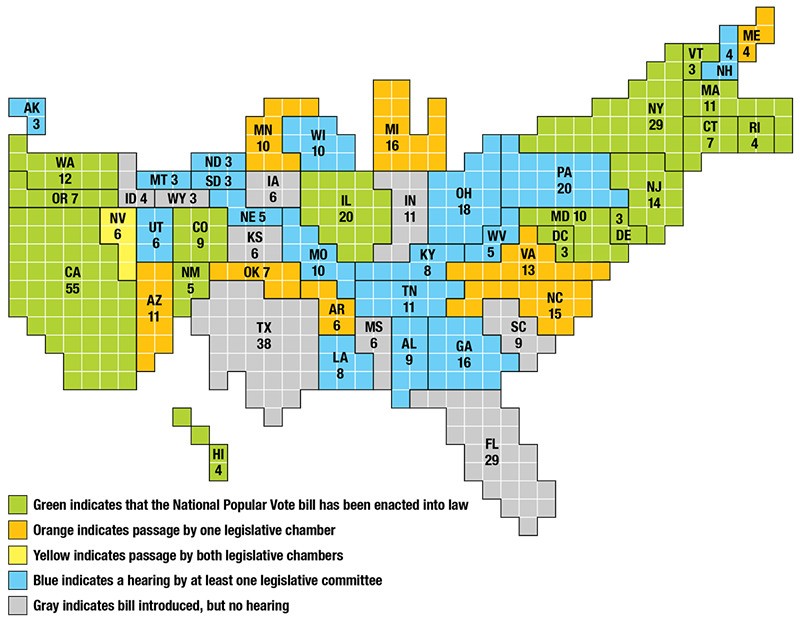Multiple States Adding Up To A Combined Total of At Least 270 Electoral Votes to Force Electors in These States to Cast Their Electoral Vote for the President and Vice-Presidential Pair Receiving the Highest Number of Votes Across All Fifty (50) States During the General Election
There is a multi-State effort underway to do things differently in terms of the votes from the citizens and what some chosen electors will do for the electoral vote.
A group of States have chosen to join forces in such a way that the highest number of votes nationwide from the citizens across all fifty (50) States (considered as the Popular Vote) will always determine the next President and Vice President because these States will always add up to the 270 Electoral votes required to award the office of President and Vice President.
The States who have chosen to join forces for this approach are shown in green on the map below. As of now, these States have reached an Electoral vote total of 196 votes, which is 74 votes shy of the required 270 votes needed to determine the President and Vice President. This approach has been adopted by the green-colored States in the form of a bill (proposed legislation). The approach will remain inactive (as constructed in the bill) and will not be used in any Presidential election until the time of a Presidential election when the States that have adopted this bill meet or exceed the required 270 Electoral votes.
Theoretically, if thirty (30) States added up to a total of 270 Electoral votes, the Electors in all of these 30 States would be casting their Electoral votes for the President / Vice-President receiving the highest number of votes from the citizens as totaled from all fifty (50) States plus the District of Columbia. Knowing in advance that the required number of Electoral votes has been achieved, would the other States still send Electors to their respective State capitols in December to cast an Electoral Vote? An Electoral vote wouldn’t be necessary in any of these other States since the requirement of 270 Electoral votes would already be satisfied using this multi-State approach.
If you reside in a State that has agreed to take part in this approach, here’s one interesting example to consider:
It’s time to inaugurate another President in January. As a registered voter, you cast your vote for President and Vice President. The votes in your State are counted as accurately as possible, and it is determined that the highest number of votes in your State were cast for the Republican candidate. If the highest number of votes nationwide went to the Democratic candidate, based on adding up all of the votes across all fifty (50) States, your State would be awarding the Presidency to the Democratic candidate, even though the Republican candidate received more votes in your State.
The rationale behind this approach is to “guarantee” or “make for certain” that the Electoral vote will always match the so-called “Popular Vote” which refers to the highest number of votes nationwide for a candidate across all fifty (50) States.
Who’s on board:
(Green-colored States have already adopted a bill agreeing to conduct their Electoral voting using this other approach, but the approach will not be used in an actual election until the group of States agreeing to use this approach have reached an Electoral vote count of at least 270 votes)


